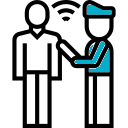
If you’ve been in a car accident where you’ve suffered physical injury, you may need to make a personal injury claim against whoever may be at fault for the accident. However, notifying responsible parties after an accident can be supremely difficult if you didn’t take the right steps to get their information in the ensuing chaos.
Yet not all is lost. Following this short guide on notifying responsible parties properly — including how to identify them in the first place — can help you through this difficult time.
Safety First
Even before notifying responsible parties after a car crash, there are some crucial first steps that you must take. First and foremost, you’re going to need to ensure that everyone involved in a traffic collision is safe and secure. This means making sure that you, or anyone else that needs it, seek medical attention immediately.
Once there’s no immediate danger to life and limb, there are some other things you’ll need to do the following. Believe it or not, these actions all fall under the same “safety first” category, as taking these actions don’t just protect your physical well-being but the legal rights and responsibilities of everyone involved. These activities include:
- Filing an accident report: this document, which contains an “official” version of what happened in the accident according to the police, will serve as the basis for any subsequent insurance or injury claims
- Exchanging contact information: no matter who’s at fault (more on that below), be sure to exchange your contact information with everyone involved in the accident, drivers and passengers alike. More than just name and phone number, this means your driver’s license number and your car insurance details as well
- Remain as calm as possible: directly after an accident is an emotional time, so be careful what you say. Demonstrating anger towards other drivers, no matter how warranted, can come back to hurt you if the case goes to court. Likewise, never discuss fault with anyone else who was involved either, as this could have negative consequences as well
Who Needs Notifying After a Crash
 Notifying responsible partiesOnce you’ve gotten through the initial event, you’ve safeguarded your physical health and you’ve taken steps to protect your legal rights and responsibilities it’s time to determine who you need to notify. You’ll have to determine who was ultimately responsible for the accident if you want to recover the cost of any damages to your property or any medical bills or loss of income due to an injury.
Notifying responsible partiesOnce you’ve gotten through the initial event, you’ve safeguarded your physical health and you’ve taken steps to protect your legal rights and responsibilities it’s time to determine who you need to notify. You’ll have to determine who was ultimately responsible for the accident if you want to recover the cost of any damages to your property or any medical bills or loss of income due to an injury.
While it’s often as simple as that, deciding who’s at fault can sometimes be more complex than simply whoever was driving the other vehicle. Besides the other driver, responsible parties can include the owner of the vehicle, the driver’s employer if they were working at the time, your insurance company or the insurer of another involved party, passengers whose actions might have led to the accident occurring, or any number of other possibilities.
How Notifying Responsible Parties Works in Practice
Once it’s become clear who should be held responsible for your accident — or at least who you think should be held responsible, the next step is to write an official notification letter. The sooner you draft and send this letter the better, as the purpose of the letter is to inform the other party that you intend to claim compensation for damage to your property or injury to yourself.
Drafting this letter can be tricky. In fact, you don’t have any need to discuss why you feel the other party is at fault, how you were injured, or even how bad those injuries are. Just as discussing certain things at the time of the accident can hurt your chances of a successful claim, the same applies to the letter as well. Instead, keep these letters simple and to the point by including the date, your name and address, and when and where the accident took place.
Additionally, it’s considered standard practice to include a request for a confirmation letter. Also, it’s also considered appropriate to request that they contact their own insurance company if you haven’t done so yourself.
When You’re Notifying Insurance Companies
In the event that you’re not just sending a notification letter to the other driver but instead to an insurance company, whether yours or another’s, you need to include some more information than simply your contact information and when and where the accident took place. In fact, you will also need to provide contact information tor the other driver, which should include their name, address, phone number, and whether or not they have an active policy with the insurer.
If you are uncomfortable with contacting responsible parties yourself, it’s recommended that you seek the advice of a qualified personal injury claims lawyer to help you. This is especially true if you are making a claim directly against an insurance company, as this can be a harrowing experience for anyone unfamiliar with the process.
A Final Word/Quick Tips
Notifying responsible parties in the wake of an accident can be difficult, so keep in mind the following quick tips as we recap what we’ve learned:
- After ensuring everyone’s immediate safety, always protect your rights directly following the accident.
- Write letters to anyone who you think might be responsible, even if it turns out they aren’t. Writing a notification letter does not mean you then have to bring a claim against them.
- Don’t skip anyone — if your insurer or lawyer finds fault with someone that you didn’t notify, starting a claim against them can be difficult.
- Send letters out as soon as possible, when you’re still familiar with what happened during the accident and your memory is clear.
- Your letter is a legal document — remain professional and don’t use any inappropriate language.
- Always make copies of every letter you send out for your own records.
- Send your letters with return receipt requested to ensure delivery.
- Partner with an attorney if you feel uncomfortable going through this process yourself.